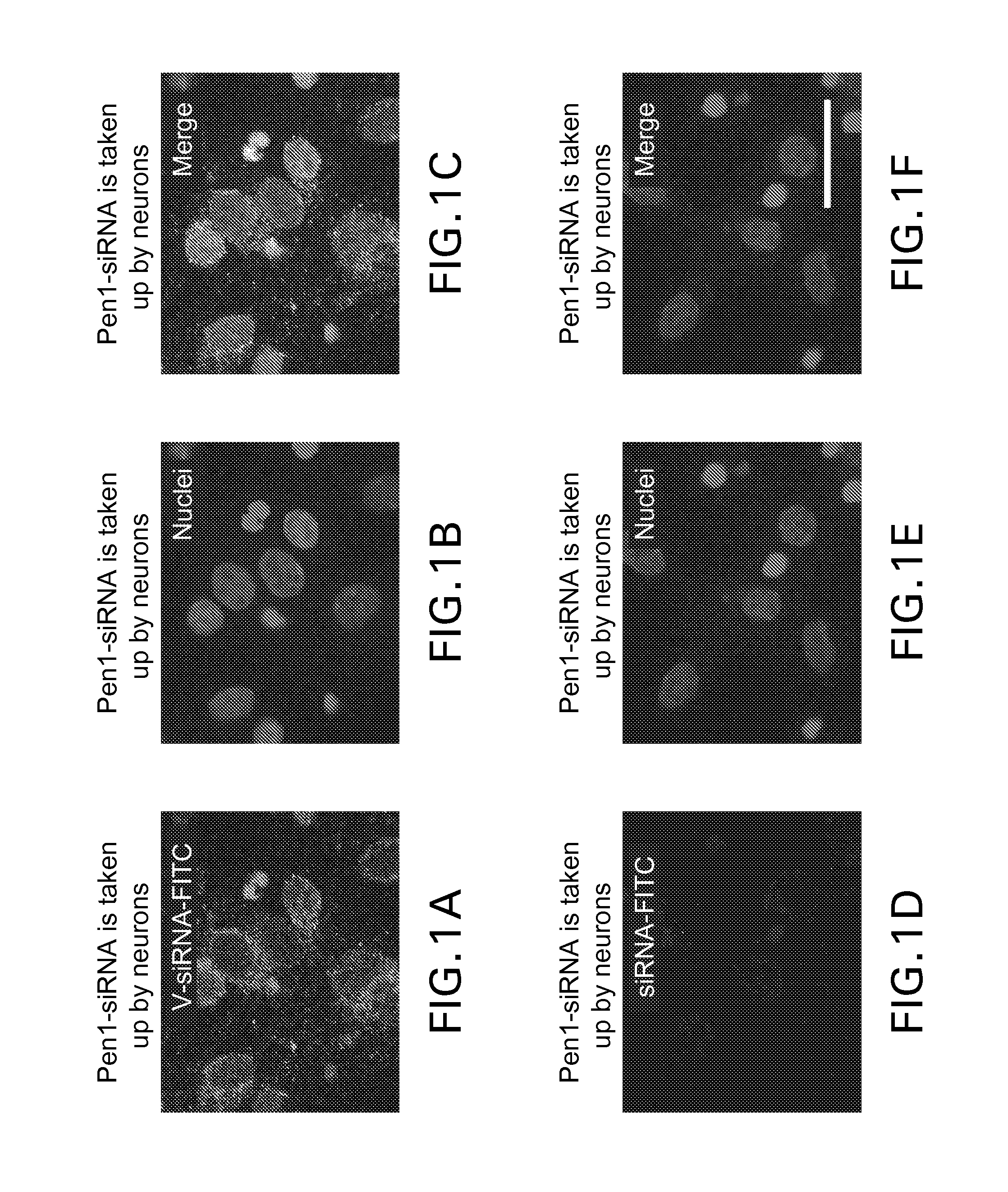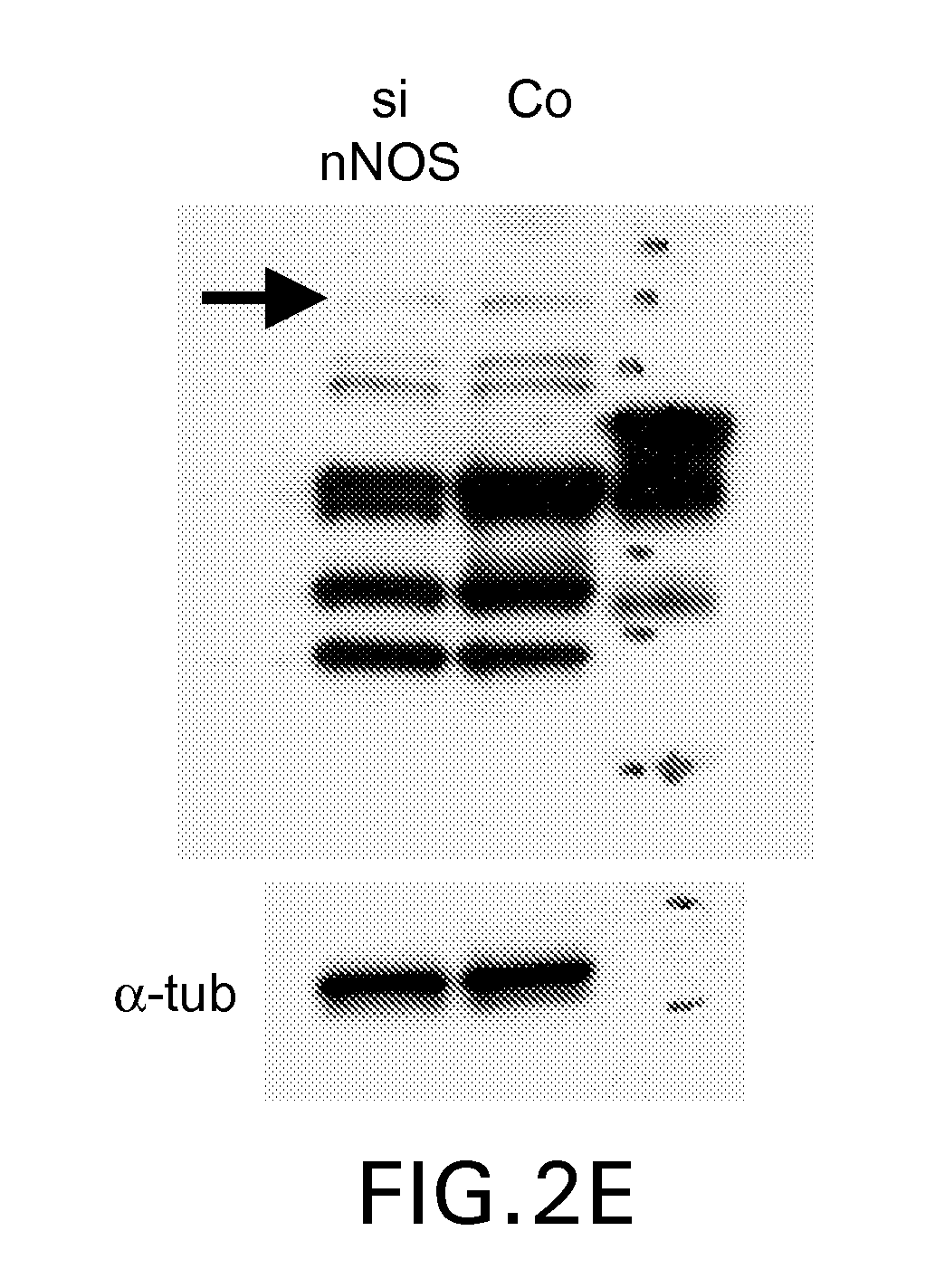Delivery Of Double-Stranded RNA Into The Central Nervous System
a technology of central nervous system and double-stranded rna, which is applied in the direction of biochemistry apparatus and processes, peptide/protein ingredients, therapy, etc., can solve the problems of ineffective brain tissue process, slow and inefficient process, and ultimately clinically inadequate methods, so as to reduce tumor growth, promote tumor apoptosis, and inhibit tumor growth
- Summary
- Abstract
- Description
- Claims
- Application Information
AI Technical Summary
Benefits of technology
Problems solved by technology
Method used
Image
Examples
example 1
6 Example 1
Generation of siRNA Sequences
[0112]siRNA sequences: siRNA were designed to target various mRNAs. A general strategy for designing siRNAs comprises beginning with an AUG stop codon and then scanning the length of the desired cDNA target for AA dinucleotide sequences. The 3′ 19 nucleotides adjacent to the AA sequences were recorded as potential siRNA target sites. The potential target sites were then compared to the appropriate genome database, so that any target sequences that have significant homology to non-target genes could be discarded. Multiple target sequences along the length of the gene were located, so that target sequences were derived from the 3′, 5′ and medial portions of the mRNA. Negative control siRNAs were generated using the same nucleotide composition as the subject siRNA, but scrambled and checked so as to lack sequence homology to any genes of the cells being transfected. (Elbashir, S. M., et al., 2001, Nature, 411, 494-498; Ambion siRNA Design Protoco...
example 2
7 Example 2
Preparation of Cell-Permeable Complex
[0114]Penetratin-1 cell-penetrating peptide: Penetratin-1 (mw 2503.93) comprising the peptide sequence RQIKIWFQNRRMKWKK (SEQ ID NO:7) (QBiogene, Inc., Carlsbad, Calif.) was reconstituted to 2 mg / ml in RNase / DNase sterile water (0.8 mM). siRNA (double-stranded, annealed, and synthesized with a 5′-thiol group on the sense or antisense strand) was reconstituted to 88 μM in RNase- / DNase-free sterile water. To link the Penetratin-1 to the siRNA, 25 μl of Penetratin-1 were added to 225 μl of the diluted oligo, for total volume of 250 μl. This mixture was incubated for 15 min at 65° C., followed by 60 min at 37° C., then stored at 4° C. Alternatively, where only small amounts of the mixture are required, these were aliquoted and stored at −80° C. Linkage was be checked by running the vector-linked siRNA and an aliquot that had been reduced with DTT on a 15% non-denaturing PAGE. siRNA was visualized with SyBrGreen (Molecular Probes, Eugene, Or...
example 3
8. Example 3
Transfection Efficiency of Cells in Culture
[0115]Transfection efficiencies of neuronal cells are generally low. To increase efficiency of delivery of siRNA to neuronal cells, a cell-permeable complex was created in which an siRNA molecule was linked to a cell-penetrating peptide. Specifically, either of the sense or antisense strand of each siRNA was modified at its 5′ end with a thiol group by methods known in the art, and covalently bonded via a disulfide bond with a Penetratin-1 peptide having a pyridyl disulfide function at its terminal end. The cell-permeable complex was incubated with sympathetic neuron cultures, and efficiency of transport into the cells was visualized immunohistochemcally.
Primary mouse sympathetic neuron cell cultures: Cell cultures were prepared as follows. Sympathetic neuron cultures were prepared from 1-day-old wild-type mouse pups, as previously described (Troy, et al., 2000, J. Neurosci., 20, 1386-1392). Cultures were grown in 24-well collag...
PUM
| Property | Measurement | Unit |
|---|---|---|
| volume | aaaaa | aaaaa |
| flow rates | aaaaa | aaaaa |
| flow rates | aaaaa | aaaaa |
Abstract
Description
Claims
Application Information
 Login to View More
Login to View More - R&D
- Intellectual Property
- Life Sciences
- Materials
- Tech Scout
- Unparalleled Data Quality
- Higher Quality Content
- 60% Fewer Hallucinations
Browse by: Latest US Patents, China's latest patents, Technical Efficacy Thesaurus, Application Domain, Technology Topic, Popular Technical Reports.
© 2025 PatSnap. All rights reserved.Legal|Privacy policy|Modern Slavery Act Transparency Statement|Sitemap|About US| Contact US: help@patsnap.com



